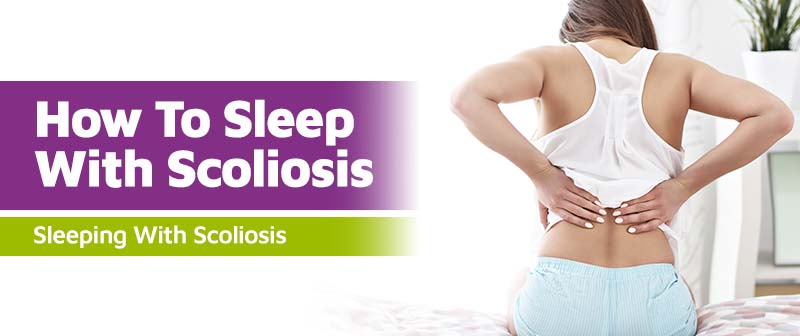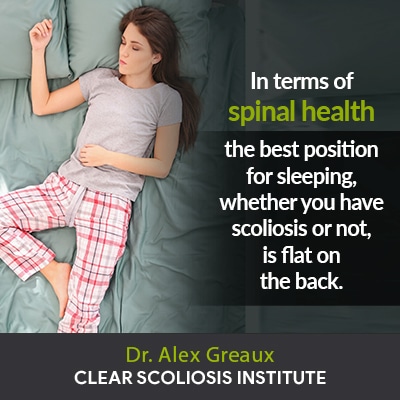
Everyone needs sleep to reset, rejuvenate, and restore. For people facing the additional challenge of life with scoliosis, it’s particularly important to develop healthy sleep habits so the body can cultivate an environment that’s conducive to healing and responsive to treatment.
While having scoliosis doesn’t guarantee sleep problems, it can increase the likelihood, especially if severe, or left untreated. Awareness of the best sleep positions for people with scoliosis, plus the merits of proactive treatment, can help counteract condition-related sleep issues.
Before moving on to the best and worst sleep positions for people with scoliosis, let’s first discuss the condition itself, for a better overall understanding of how it can affect a person’s ability to get a good night’s rest.
Scoliosis is an abnormal sideways spinal curvature, with rotation, and a Cobb angle measurement of 10+ degrees.
Cobb angle refers to how tilted the vertebrae (bones of the spine) are in the unnatural curvature, and indicates how far out of alignment a scoliotic spine is.
When the spine is misaligned, this means that the vertebrae are no longer stacked on top of one another in a straight alignment, which is needed for the spine to function optimally.

A person’s experience of life with the condition is shaped by a number of important patient/condition variables: patient age and overall health, condition type, curvature location, and condition severity.
While some patients might find sleeping with scoliosis to be a challenge, it’s not uncommon for people to go through life completely unaware they even have scoliosis, especially with mild forms.
Scoliosis can range from mild to moderate and severe, but as a progressive condition, where a person’s scoliosis is at the time of diagnosis is not indicative of where it will stay; it’s in the condition’s nature to worsen over time, especially if left untreated.
While every case is different and there are no treatment guarantees, proactive treatment can help manage progression, along with addressing the underlying cause of related symptoms, such as sleep troubles.
So while no two cases are the same, what are some of the most common symptoms of scoliosis, and how exactly can having scoliosis affect sleep?
As mentioned, there are numerous variables that shape a person’s experience of life with scoliosis; each patient responds to the condition, and treatment, in their own unique way.
As the brain and spine work in tandem to form the body’s central nervous system (CNS), scoliosis can disrupt brain-body communication and produce a myriad of effects, including sleep troubles.
While the most common symptoms of scoliosis are pain and postural changes, the former is largely determined by patient age, and in severe cases, lung impairment can also become an issue that affects sleep.
Pain and Postural Changes
Understandably, the more painful a condition is, the more likely it is to affect a person’s ability to get a good night’s sleep.
With scoliosis, the condition’s most common form is adolescent idiopathic scoliosis (AIS), diagnosed between the ages of 10 and 18, and for this age group, the condition isn’t typically painful, and this is due to growth and skeletal maturity.
If a person is still growing, they have not yet reached skeletal maturity. As a growing spine is experiencing a constant lengthening motion, it can counteract the compressive force of an abnormal spinal curve, known to be the main source of condition-related pain.
For adults with scoliosis, the condition has become compressive and the main symptom is pain, which is what brings most adults in to see me for a diagnosis and treatment.
The level of pain is determined by the various factors mentioned earlier - patient age, condition type, curvature location, condition severity - and is also largely affected by the degree of nerve involvement.
If a scoliotic curve is compressing a nearby nerve, its effects can be felt far from its site of origin, and this is because nerves are like branches on a tree, fanning off in multiple directions, which is why adult scoliosis pain is felt not just in the back, but also commonly in the legs and feet.
As mentioned, scoliosis can also cause postural changes such as uneven shoulders, shoulder blades, the presence of a rib arch, an uneven waistline, etc.
When scoliosis causes postural changes, it doesn't just affect the spine, but also its surrounding muscles and ligaments, and the uneven forces of a scoliotic curve can cause stiff and sore muscles as they struggle to support and stabilize the spine, and of course, muscle pain and/or spasms can also disrupt sleep.
So pain as a scoliosis symptom can most certainly disrupt sleep, but these types of issues are more likely to be part of the adult experience with scoliosis.
Lung Impairment
Although not a common symptom, in severe cases, lung impairment, also known as thoracic insufficiency syndrome (TIS), can also come into play, and while this is mainly noticeable during times of physical exertion, some patients’ respiratory issues can also impact sleep.
Particularly with thoracic curvatures (middle/upper back), a scoliotic curve can disrupt the position of the rib cage and cause pain related to muscular issues and/or restricted joints and ligaments.
When inhaling, the rib cage expands up and out to allow for optimal air flow into the chest cavity.
You might also like: Living With Scoliosis
If scoliosis has caused the development of a rib arch and/or is causing rib pain that affects the ability of the rib cage to fully expand, this can decrease a patient’s ability to breathe normally and disrupt sleep.
Now that we have discussed the nature of scoliosis and how some of its symptoms can disrupt sleep, let’s move on to address the specifics of the best and worst sleep positions for people with scoliosis.
I first want to make it clear that as scoliosis is a structural condition, there is no sleep position with corrective potential; our current discussion on how to sleep with scoliosis is in the context of pain relief and condition management.
For someone with scoliosis wanting to induce a structural change during sleep, this would require the use of a corrective brace: a common scoliosis treatment modality.

For those with spinal conditions, sleeping flat on the back with a cervical pillow to provide optimal support for the neck can help straighten the back as much as possible and keep the spine in a neutral and relaxed position.
As we know that scoliosis causes an unnatural spinal curve, trying to maintain body positioning that doesn’t play into the asymmetrical effect of scoliosis is key for all aspects of life, including sleep.
Sleeping flat on the back doesn’t expose the spine to uneven pressure and keeps it as straight, neutral, and aligned as possible.
When it comes to side sleeping, there is no particular side that’s better for people with scoliosis; for example, if you have a left-lumbar curve, sleeping on the left won’t alleviate any condition-related sleep problems, nor will sleeping on the right.
When it comes to side sleeping, it’s more about preference. If sleeping on the back isn’t an option, the next best position for sleeping with scoliosis is on the side that’s the most comfortable.
Now that we have addressed the best positions for sleeping with scoliosis, let’s talk about bad positions for sleeping with scoliosis.
When it comes to bad positions for sleeping with scoliosis, again, it’s the same for people with or without the condition: sleeping on the stomach is the worst position for spinal health.
Sleeping flat on the stomach makes the head and neck twist at an unnatural angle and can cause an unnatural arching of the spine, which exposes an already misaligned spine to more uneven forces.
Any position that causes an unnatural arching or twisting of the back should be avoided by people with scoliosis because their spines are already misaligned and exposed to uneven pressure/compression.
When it comes to living with a condition like scoliosis, developing healthy lifestyle habits are important, not just in terms of overall health and wellness, but also in priming the body for healing and responsiveness to treatment.
Knowing the best sleep positions for people with scoliosis can be helpful with reducing discomfort and ensuring the spine isn’t being exposed to any additional uneven forces that can exacerbate the condition’s asymmetrical effects.
It’s also important to understand that there is no sleep position with corrective potential.
While there are no treatment guarantees, the best way to address scoliosis symptoms is to seek out effective and proactive treatment as close to the time of diagnosis as possible; as mentioned, scoliosis is not a static condition, so efforts need to be made to prevent increasing condition severity.
As a CLEAR-certified scoliosis chiropractor, I assess and treat the entire spine and work closely with my patients to impact the condition on a structural level, in the form of a curvature reduction.
Through physical therapy and the use of scoliosis-specific exercises (SSEs), I also work towards increasing core strength so the muscles surrounding the spine are strengthened and better able to provide it with optimal support and stabilization.
While no two people will experience their condition in exactly the same way, common symptoms of scoliosis include postural changes and pain (more common in adults).
Scoliosis-related sleep problems can be caused by muscle soreness, localized back and/or radicular pain, and in severe cases, lung impairment.
In addition to proactive treatment that addresses the underlying structural nature of the condition, knowing how to sleep with scoliosis means being aware of the best and worst positions for spinal alignment, which are the same for people with or without scoliosis; sleeping flat on the back is best, followed by side sleeping, and the worst sleep position is flat on the stomach.

CLEAR provides a unique and innovative way of understanding scoliosis. Sign up to receive facts and information you won’t find anywhere else.
